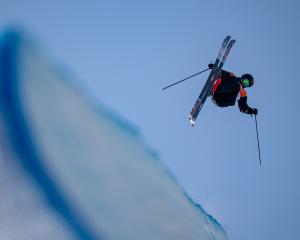Winter Games NZ organisers say the event will become self-sustaining this year, with long-term economic impacts far exceeding those expected from the Rugby World Cup.
Reserve Bank governor Alan Bollard in January predicted September's Rugby World Cup would add about $700 million to the national economy, but Winter Games NZ economic forecasts are for a far more modest $50 million from the August event.
However, the Winter Games NZ had a long-term vision and was not a one-off event but a "legacy event" similar to the long-standing AJ Hackett bungy jump operation in Queenstown, event organiser Arthur Klap said at a Lake Wanaka Tourism presentation in Wanaka on Monday night.
"AJ Hackett started with $5000 about 22 years ago ... With the Winter Games, we have the opportunity to do the same thing.
I want to be invited back in 20 years' time and sit back, watching something far bigger and greater than what it is today," he said.
The games would be closely surveyed to see if growth targets were met, Mr Klap said.
Mr Klap said he had organised 12 one-off world championship events in New Zealand and had pulled out of organising the World Rowing Championships in Hamilton to focus on the Winter Games, which was launched in 2009 as a biennial event.
"I believe this is much, much harder even than the Rugby World Cup. The return [long term] would far exceed anything I've seen with that," he replied.
Within 10 years, the games should be financially self-sustaining and the major funders would not be trusts or central and local governments, he said.
In 2009, the commercial contribution to the $3.3 million budget was 11%, but this year the commercial contribution to the $4 million budget would be 25%.
The goal was to raise 45% of the budget from sponsors by 2013 and to increase that to 90%-95% in 10 years.
Mr Klap acknowledged community feedback after the 2009 games that the event had no visible presence in Wanaka or Queenstown - people had no idea it was on.
A new festival component, costing about $25,000, would be run in conjunction with this year's games.
Awards ceremonies would be held "downtown" rather than on the mountain, so more people could interact with their snowsports "superstars".
The Winter Games office would also be based in Wanaka because it had the most venues, Mr Klap said.
Wanaka would host nine awards ceremonies and Queenstown would get four. Other ceremonies would be held in Dunedin, Naseby and Methven.
Lake Wanaka Tourism general manager James Helmore said yesterday the Winter Games "is a really good vehicle to promote Wanaka as a holiday and visitor destination" and would be a driver for economic growth.
Mr Helmore said he shared Mr Klap's confidence the seed had been sown for "an enormous" economic footprint in the long term.
The ability for visitors to be able to connect with superstars at awards ceremonies and the downtown festival events would add significant value, he said.
"I think he [Mr Klap] is being very, very realistic and very very conservative. Every goal they've put out has been exceeded ... That's a sure way to grow it, in a sustainable manner.
"At the first Winter Games, the brand meant nothing. But now it is just about to get into first gear, and the foot is on the accelerator," Mr Helmore said.
Lake Wanaka Tourism has an annual budget of about $700,000 and has contributed a "small amount" to the Winter Games because it sees the event as one of the key planks in a Wanaka event strategy that includes Warbirds Over Wanaka, Challenge Wanaka, the Festival of Colour and Wanakafest.
Mr Helmore declined to say how much was contributed because it was nowhere near the $100,000 contribution Destination Queenstown was able to make from its $3.3 million annual budget
2011 Games goals
• 17 days (up from 9 in 2009)
• $50 million economic impact (up from $45 million in 2009)
• 800 million target television audience (up from 765 million in 2009)
• 900-1000 elite athletes (up from 816 in 2009)
• 1700 international visitors
• 2000 domestic visitors
• Increase in average length of stay of 50% (6.6 nights in 2009)
• 5000 print media downloads (up from 3000 in 2009)










